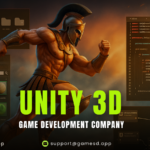Imagine stepping into a world where dragons soar over neon-lit cities, players battle across planets, and every scene feels alive, without a single line of code slowing you down. That’s the magic of Unity 3D Game Development. From indie hits to blockbuster titles, Unity transforms creative ideas into immersive realities.
Its versatility, cross-platform support, and feature-rich toolset make it the go-to solution for developers who want to craft engaging, interactive worlds quickly and efficiently. In today’s gaming landscape, mastering Unity isn’t just an option; it’s the key to bringing your game visions to life.
What Is Unity 3D Game Development? A Quick Breakdown
Unity 3D Game Development refers to the process of using the Unity Game Engine to design, build, and deploy interactive 3D games. It involves integrating assets, scripts, animations, and physics to create visually engaging and mechanically robust gameplay experiences. The platform supports multiple devices and operating systems, making it ideal for reaching a wide audience. Unity Game Developers can leverage both 2D and 3D tools to craft highly immersive experiences, from realistic simulations to imaginative fantasy worlds.
Key Tools in Unity 3D Game Development
Unity Editor & Scene View
The Unity Editor is the primary interface for game creation, allowing developers to manage assets, organize scenes, and control gameplay logic. The Scene View offers a visual representation of the game world, helping developers position objects, lighting, and cameras with precision.
Asset Store Integration
Unity’s Asset Store provides a vast library of pre-built models, textures, animations, and scripts. By utilizing these assets, developers can save time while maintaining high-quality visuals and functionality, speeding up development without compromising creativity.
Physics, Lighting, and Animation Tools
Unity offers advanced physics engines, lighting systems, and animation tools. Realistic object movement, dynamic shadows, and smooth character animations are all possible thanks to these integrated features. These tools enable developers to craft engaging and lifelike game environments.
Core Technologies Powering Unity 3D Games
Cross-Platform Engine Capabilities
Unity’s cross-platform support allows developers to deploy games on Windows, macOS, Android, iOS, consoles, and VR/AR devices without major rewrites. This capability significantly reduces development time and increases market reach.
C# Scripting & Visual Scripting
Unity uses C# as its primary scripting language, enabling precise control over game mechanics. Visual scripting options are also available for developers who prefer a node-based approach, allowing both programmers and designers to contribute to game logic efficiently.
Real-Time Rendering and GPU Optimization
Unity’s real-time rendering engine ensures that high-quality graphics are displayed smoothly. GPU optimization techniques enhance performance, enabling developers to create detailed environments and complex simulations without lag or frame drops.
Unity 3D Development Techniques for Immersive Worlds
Procedural Generation & Terrain Building
Procedural generation enables game developers to create vast, dynamic game worlds with minimal manual input. Coupled with terrain tools, developers can craft landscapes ranging from realistic mountains to fantastical environments efficiently.
AI Integration and Behavior Design
AI systems within Unity enable NPCs to react intelligently to player actions. By designing behavior trees, pathfinding algorithms, and adaptive responses, developers can deliver more engaging and challenging gameplay experiences.
Realistic Lighting, Shadows & Particle Effects
Advanced lighting techniques, dynamic shadows, and particle effects enhance immersion. Unity allows developers to simulate natural sunlight, ambient light, and interactive particle systems that make the game world feel alive.
Unity 3D for AR, VR, and Metaverse Game Development
Building Interactive XR Experiences
Unity 3D facilitates AR and VR development, enabling developers to design interactive experiences that blend real and virtual environments. Immersive simulations, training apps, and VR games are all achievable with Unity’s XR tools.
Unity’s Role in Metaverse World Creation
With the rise of Metaverse Game Development, Unity has emerged as a key engine for building virtual worlds. Developers can integrate social features, NFT assets, and real-time interactions to create scalable, interactive Metaverse experiences.
Benefits of Using Unity 3D Game Engine for Developers
Faster Prototyping & Asset Reusability
Unity Game Engine allows developers to rapidly prototype ideas and reuse assets across multiple projects. This flexibility reduces production costs while accelerating time-to-market.
Smooth Multiplayer and Cloud Sync
Developers can integrate multiplayer features and cloud-based syncing, enabling players to connect across platforms in real time. This ensures smoother gameplay and enhances social interaction within games.
Common Challenges in Unity 3D Game Development
Performance Optimization
Optimizing frame rates and memory usage can be challenging. Unity provides profiling tools and GPU/CPU management systems to help developers maintain smooth gameplay.
Asset Management and Memory Control
Handling large volumes of assets and managing memory efficiently is crucial. Unity’s asset bundles, addressable assets, and resource management techniques allow developers to organize content and prevent performance bottlenecks.
Why Choose GamesDapp for Unity 3D Game Development?
GamesDapp is a leading Unity 3D Game Development Company, offering end-to-end solutions for game creation. Our team of skilled Unity Game Developers ensures high-quality performance, immersive graphics, and scalable architecture.
This Halloween, take advantage of our special 30% discount on all game development projects. Whether you are building a mobile game, VR experience, or Metaverse-ready world, GamesDapp combines expertise, creativity, and technology to bring your vision to life.

